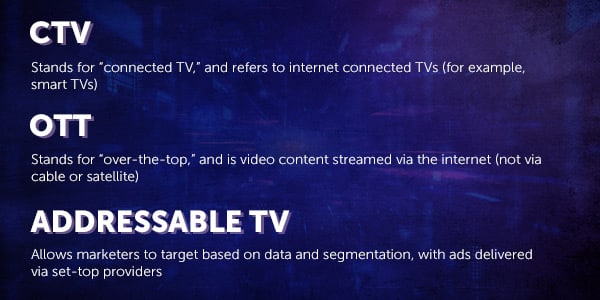Addressable TV vs Connected TV Advertising

Once upon a time, before addressable TV advertising, television was just … TV. There was an evolution from black-and-white to color, from antennae to cable to satellite, and the sets themselves got flatter and wider. But the ads you saw during a program (which you watched at a specified time as there was no such thing as pausing or DVRing for later) were the same as what everyone else saw, or at least everyone else in the same geographic area.
Now, however, ads can be targeted not just based on what consumers are watching, but also the household in which they live. Now there’s addressable TV advertising, over-the-top (OTT), connected TV (CTV), MTV – wait, no, that last one’s how video killed the radio star. But when we’re talking about the types of TV advertising and how ads reach households, do you even know your addressable from your elbow?
Below, we’ll explore addressable TV advertising – in this case, addressable linear TV – and how it compares to OTT and CTV advertising.
What Is Addressable TV & How Does It Work?
When we talk about addressable linear TV, we’re referring to ads targeted based on household-level data and segmentation to serve ads during TV programming. Addressable linear TV ads are served primarily through set-top providers (cable services like Comcast or Time Warner) or Video on Demand (VOD) inventory. For example, by using first and third-party data, an automobile company might in theory advertise a minivan to a household with two adults and young children, and a coupe to a household with a younger single adult.
A big challenge for marketers interested in addressable linear, however, is lack of scale. We’ll dive into that a bit more below.
What’s the difference between traditional linear TV advertising and addressable linear TV advertising?
Traditional linear TV features advertising based on Nielsen targeting via panels and analysis by geographic area, as well as a general target for the assumed audience. Think about the latter this way: The soap opera was named for the mid-afternoon radio dramas sponsored by (and thus bookended with ads for) soap companies. The idea was that the audience was most likely to be housewives who would be the proper target audience for home and personal hygiene supplies. Same as why the Saturday morning cartoons of old were often peppered with kid-centered advertisements that made parents groan. Such general strategies largely continue in traditional linear today.
Addressable linear TV, on the other hand, allows marketers to reach specific household audiences based on their respective household data, regardless of time of day, program, etc. The ads consumers are exposed to are better targeted to them, allowing marketers to focus on consumers instead of focusing on programming.
What’s the difference between addressable linear TV advertising and OTT and CTV advertising?
Both include household targeting capabilities. As mentioned above, addressable linear TV is a way to deliver household targeted ads to linear TV viewers via a set-top box. By contrast, OTT content is accessed via the internet, which enables household-targeted ads on a CTV as well as on a laptop, tablet or phone.
Basically, while both capabilities enable marketers to use data to reach household audiences instead of program-based or panel-based audiences, the main difference is that CTV and OTT advertising are delivered through an internet-connected device via providers such as Netflix, Hulu and Peacock, to name a few. You can learn more about the differences between OTT and CTV in our blog post.

Is CTV a better value for advertisers than addressable TV advertising?
By definition, all CTV advertising is addressable TV advertising, whereas only a very small percentage of linear TV is addressable. CTV is scalable, whereas the limited scale of addressable linear TV advertising poses a challenge to marketers. As we discussed in a recent blog post, CTV is arguably the most quality form of advertising for a number of reasons.
CTV advertising also allows marketers the opportunity to weave in more and better types of data, including Automated Content Recognition (ACR), which can help a brand more accurately target, deliver and measure their ads.
CTV finally bridged the gap of digital marketing advantages like robust data targeting, flexible optimization and superior measurement with the benefits that TV provides. Marketers can take advantage of large, full screens that provide 100% share of voice (SOV), brand-safe environments and a proven medium for engaging audiences as a cohesive portion of a larger omnichannel campaign. These aspects are key drivers in the explosion of CTV advertising we are experiencing today.
In addition, thanks to the continued acceleration of cord-cutting, CTV advertising provides a way for marketers to reach consumers who no longer pay for traditional cable TV. As streaming content continues to grow in popularity and automation of linear TV continues to advance, working with a DSP like Viant’s to purchase your programmatic linear TV advertising and CTV advertising can help you create a stronger and more robust advertising strategy centralized in one holistic platform.
If you’d like to learn more about Viant’s TV advertising capabilities, reach out to a representative today.
STAY IN THE LOOP WITH OUR NEWSLETTER
Sign up to get Viant news and announcements delivered straight to your inbox.
Sign up to get Viant news and announcements delivered straight to your inbox.
